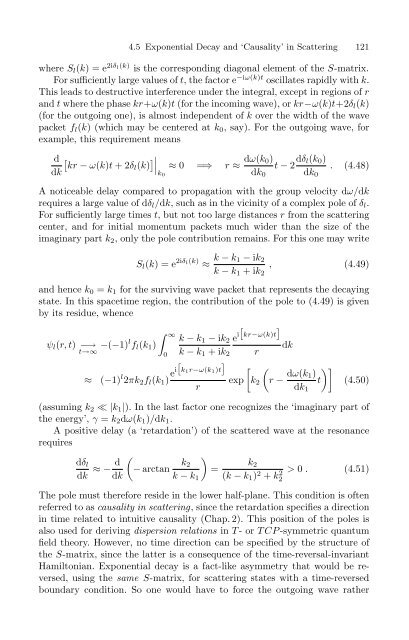The Physical Basis of The Direction of Time (The Frontiers ...
The Physical Basis of The Direction of Time (The Frontiers ...
The Physical Basis of The Direction of Time (The Frontiers ...
Create successful ePaper yourself
Turn your PDF publications into a flip-book with our unique Google optimized e-Paper software.
4.5 Exponential Decay and ‘Causality’ in Scattering 121<br />
where S l (k) =e 2iδ l(k) is the corresponding diagonal element <strong>of</strong> the S-matrix.<br />
For sufficiently large values <strong>of</strong> t, the factor e −iω(k)t oscillates rapidly with k.<br />
This leads to destructive interference under the integral, except in regions <strong>of</strong> r<br />
and t where the phase kr+ω(k)t (for the incoming wave), or kr−ω(k)t+2δ l (k)<br />
(for the outgoing one), is almost independent <strong>of</strong> k over the width <strong>of</strong> the wave<br />
packet f l (k) (whichmaybecenteredatk 0 , say). For the outgoing wave, for<br />
example, this requirement means<br />
d [<br />
kr − ω(k)t +2δl (k) ]∣ ∣<br />
∣k0 ≈ 0 =⇒ r ≈ dω(k 0)<br />
t − 2 dδ l(k 0 )<br />
. (4.48)<br />
dk<br />
dk 0 dk 0<br />
A noticeable delay compared to propagation with the group velocity dω/dk<br />
requires a large value <strong>of</strong> dδ l /dk, such as in the vicinity <strong>of</strong> a complex pole <strong>of</strong> δ l .<br />
For sufficiently large times t, but not too large distances r from the scattering<br />
center, and for initial momentum packets much wider than the size <strong>of</strong> the<br />
imaginary part k 2 , only the pole contribution remains. For this one may write<br />
S l (k) =e 2iδ l(k) ≈ k − k 1 − ik 2<br />
k − k 1 +ik 2<br />
, (4.49)<br />
and hence k 0 = k 1 for the surviving wave packet that represents the decaying<br />
state. In this spacetime region, the contribution <strong>of</strong> the pole to (4.49) is given<br />
by its residue, whence<br />
[<br />
∫ ∞<br />
ψ l (r, t) −→ −(−1) l k − k 1 − ik 2 e i<br />
f l (k 1 )<br />
t→∞<br />
0 k − k 1 +ik 2<br />
]<br />
[<br />
≈ (−1) l 2πk 2 f l (k 1 ) ei k 1r−ω(k 1)t<br />
r<br />
]<br />
kr−ω(k)t<br />
r<br />
(<br />
exp<br />
[k 2<br />
dk<br />
r − dω(k 1)<br />
t<br />
dk 1<br />
)]<br />
(4.50)<br />
(assuming k 2 ≪|k 1 |). In the last factor one recognizes the ‘imaginary part <strong>of</strong><br />
the energy’, γ = k 2 dω(k 1 )/dk 1 .<br />
A positive delay (a ‘retardation’) <strong>of</strong> the scattered wave at the resonance<br />
requires<br />
(<br />
)<br />
dδ l<br />
dk ≈−d k 2<br />
k 2<br />
− arctan =<br />
dk<br />
k − k 1 (k − k 1 ) 2 + k2<br />
2 > 0 . (4.51)<br />
<strong>The</strong> pole must therefore reside in the lower half-plane. This condition is <strong>of</strong>ten<br />
referred to as causality in scattering, since the retardation specifies a direction<br />
in time related to intuitive causality (Chap. 2). This position <strong>of</strong> the poles is<br />
also used for deriving dispersion relations in T -orTCP-symmetric quantum<br />
field theory. However, no time direction can be specified by the structure <strong>of</strong><br />
the S-matrix, since the latter is a consequence <strong>of</strong> the time-reversal-invariant<br />
Hamiltonian. Exponential decay is a fact-like asymmetry that would be reversed,<br />
using the same S-matrix, for scattering states with a time-reversed<br />
boundary condition. So one would have to force the outgoing wave rather



![arXiv:1001.0993v1 [hep-ph] 6 Jan 2010](https://img.yumpu.com/51282177/1/190x245/arxiv10010993v1-hep-ph-6-jan-2010.jpg?quality=85)


![arXiv:1008.3907v2 [astro-ph.CO] 1 Nov 2011](https://img.yumpu.com/48909562/1/190x245/arxiv10083907v2-astro-phco-1-nov-2011.jpg?quality=85)








![arXiv:1002.4928v1 [gr-qc] 26 Feb 2010](https://img.yumpu.com/41209516/1/190x245/arxiv10024928v1-gr-qc-26-feb-2010.jpg?quality=85)
![arXiv:1206.2653v1 [astro-ph.CO] 12 Jun 2012](https://img.yumpu.com/39510078/1/190x245/arxiv12062653v1-astro-phco-12-jun-2012.jpg?quality=85)
